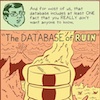CIR | Al Jazeera America | CityLab
Three good examples of illustrated journalism arrived this week. That’s not a trend, but it’s a welcome opportunity to highlight alternative storytelling forms.
• The Center for Investigative Reporting just published “Techsploitation,” a graphic novel that tells the story of an Indian man who ended up in a “guesthouse,” applying for work online after he thought he was getting a job in the States. CIR reporter Matt Smith also illustrated the book, which accompanies his much longer text-based story about shady job brokers.
The Guardian also ran “Techsploitation” online.
Meghann Farnsworth, CIR’s director of distribution and engagement, said she didn’t yet know the extent to which the partnership boosted the book’s reach, but said “On social media we’ve seen a lot of people excited to see it.” CIR is also trying to figure out how many print copies of the book to make — some will go to colleges and media organizations in India, Farnsworth said, and others might become premiums for CIR’s members.
A previous CIR graphic novel, “The Box,” was also produced by CIR’s Michael I. Schiller, and the news organization printed that one, too. “Digital is amazing, but there’s something about holding things in your hands,” Farnsworth said.
• Al Jazeera America published “Terms of Service,” a less-than-rosy look at how big data is letting companies monetize your life — and come up with their own stories about you that you can’t control. Michael Keller and Josh Neufeld wrote and star in the book, which follows them to Colorado and New York.
Rhyne Piggott, the news organization’s head of multimedia and mobile, tells Poynter in an email that AJAM plans a print version of “Terms of Service.”
• CityLab just republished “Compartment 13,” a comic by Darryl Holliday and Jamie Hibdon about the effects of anti-homeless measures in Chicago.
Holliday and Hidden created the piece for Symbolia Magazine, CityLab senior associate editor Shauna Miller tells Poynter in an email. (The piece was also published in partnership with Illustrated Press and the Journalism Center for Children on Families, which funded it.) “We did not commission Compartment 13, we simply connected with the writers on a tip from one of our staffers and took it on just as we would take a reported article from any freelancer,” she writes.
The story “is also part of a book that Darryl is working on that will provide a snapshot of life on Kedzie Avenue in Chicago,” Symbolia Editor Erin Polgreen tells Poynter in an email. Polgreen edited “Compartment 13” and plans to edit Holliday’s book as well, which Holliday plans to crowd-fund.
Miller said CityLab hadn’t run a piece like this before but said she is “embarking on editing a series on homelessness for CityLab and thought this was a really good way into the human side of the issue (which is the hardest layer to get through regarding this issue with readers).”
Related: Journalists, Artists Tell Stories with Nonfiction Graphic Novels | From radio reporter to graphic novelist, how Brooke Gladstone became a character in ‘The Influencing Machine’ | California Watch tells difficult story with video, tweets (and text)









